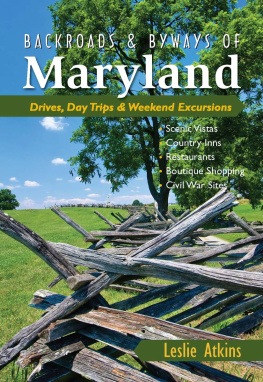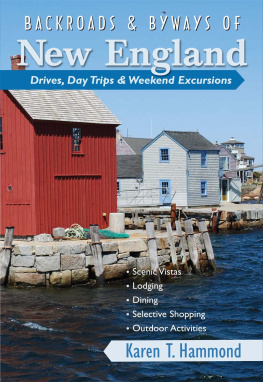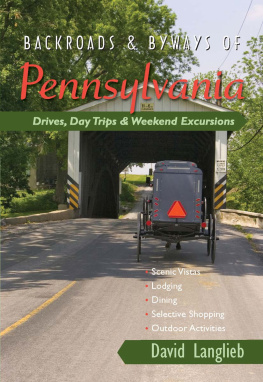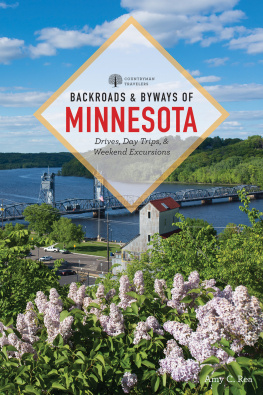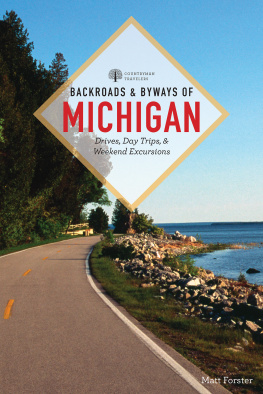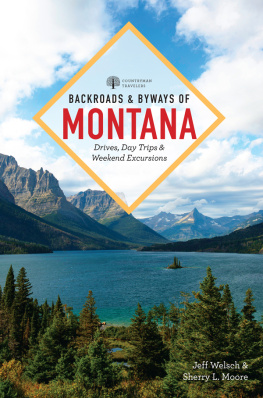BACKROADS & BYWAYS
OF
INDIAN
COUNTRY

The road through Canyon de Chelly
BACKROADS
& BYWAYS
OF
INDIAN
COUNTRY
Drives, Daytrips & Weekend Excursions
Teresa Bitler

Copyright 2012 by Teresa Bitler
All rights reserved. No part of this book may be reproduced in any form or by any electronic or mechanical means including information storage and retrieval systems without permission in writing from the publisher, except by a reviewer, who may quote brief passages.
Interior photographs by the author unless otherwise specified
Maps by Erin Greb Cartography, The Countryman Press
Book design by Susan Livingston
Composition by Chelsea Cloeter
Published by The Countryman Press,
P.O. Box 748, Woodstock, VT 05091
Distributed by W. W. Norton & Company, Inc.,
500 Fifth Avenue, New York, NY 10110
Backroads & Byways of Indian Country
978-0-88150-957-1
Printed in the United States of America
10 9 8 7 6 5 4 3 2 1
FOR MY HUSBAND, JERRY,
AND DAUGHTERS, KELLY AND KIM

The red rocks and rugged terrain surrounding Ghost RanchNew Mexico Tourism Department and Jim Stein

CONTENTS
ACKNOWLEDGMENTS
This book wouldnt have been possible without the help and support of many people, especially my husband, Jerry, who served as part-time chauffeur and full-time IT support. Without him, 90 percent of the photos that appear in this book would have fallen prey to a computer virus three days before my deadline. I know, Jerryif I backed things up on the server, or even a CD, it would make your life a whole lot easier.
I also owe a special thanks as well to my daughters, Kelly and Kim, who sacrificed three solid weeks to drive the backroads of Arizona, Colorado, New Mexico, and Utah and who had to fend for themselves while I was on the road or holed up in front of my laptop. Next summer, well vacation at a slower pace, I promise.
Others played an important role in the researching, writing, and completion of this book. Thanks to my family and friends, who encouraged me, and to all of the wonderful people I met along the way, including Hopi anthropologist Micah Lomaomvaya, James Surveyor, and the Native Americans who guided me through their sacred lands. I also want to recognize Mike Finney, Alexa Gunther, and Kathie Curley for their help in planning my itineraries, as well as the Albuquerque, Durango, Farmington, and Flagstaff Convention and Visitors Bureaus for their input.
And to the people I havent seen in what feels like months, well get together soon. Lunch is on me.

A tour group hikes past pictographs in the Ute Mountain Tribal Park.
Matt Inden of Weaver Multimedia Group and the Colorado Tourism Office
INTRODUCTION
My first encounter with Native American culture was a bite of hot, donut-like fry bread dusted with powdered sugar. I cant remember where I first ate this treat or even whenmaybe one of the few times we made it to the Arizona State Fairbut it became a fixture in my childhood. Winters, when it was cool enough to fry inside, my mother would follow the recipe from an Arizona cookbook and shape the dough into balls that she would fry to golden brown. I remember watching the bread puff, anticipating our meal of what is today referred to as an Indian taco.
Only later, as an adult, did I realize my fry bread had a story. In retaliation for repeated attacks, the United States Army launched a scorched-earth campaign against the Navajo, burning their fields, destroying their orchards, poisoning their wells, and either killing or confiscating their livestock. By December 1863, the starving Navajos had had enough, and, believing Christopher Kit Carsons promise that they would be well fed, they surrendered. Carson then marched them at gunpoint almost 300 miles to Fort Sumner.
Nearly 200 people died from cold and starvation on the Long Walk, and when they arrived at their new home, they quickly learned the promised food didnt exist. The water was brackish, the corn crop became infested with worms, and what little outside food did arrive was often spoiled. Forced to feed their families with what little resources they did have, Navajo women used Army-issue white flour, salt, baking powder, and lard to create fry bread. The Navajo and other reservation tribes adopted the meal, making it a Native American staple.
Fry bread taught me that when it comes to the Native Americans of the Southwest, past or present, what seems straightforward can often have a complicated history, layers of meaning, or several interpretations. Places can have multiple names with multiple spellings of the same name. Neighbors can disagree on what should be shared with outsiders and what is taboo. Even the stories behind historical events can vary slightly depending on whether Anglos, Hispanics, or Native Americans relay what happened. And that makes touring Indian Country different than visiting Boston or the Grand Canyon.

Southern Utah
But what really separates the Indian Country of the Southwest from other destinations is its beauty and the warmth of the people who live here. Some of the most iconic images of the Southwest can be found in this region: Monument Valley, Antelope Canyon, Bryce Canyon, and Mesa Verde. People you have met only minutes before in a village will invite you into their homes. In all the travels I completed for this book, the highlight for me was an invite from an 80-year-old Hopi medicine man to share his cupcakes and Kool-Aid.
I set out to make the Native American lands and people of the Four Corners region accessible to the average traveler. As you drive the backroads and byways of Indian Country, youll leave behind the traffic and troubles of everyday American life. Youll walk through rooms inhabited by Ancestral Puebloan Indians 900 years ago, stand over the edge of the Grand Canyon, and ride a narrow gauge railroad through traditional hunting grounds. Youll also enter villages that have been inhabited for centuries and, if youre lucky, witness ceremonial dances on the plaza.
Since some of these areas are remote, Ive provided suggestions at the end of each chapter for linking one drive to another or exploring an area further. Additionally, the appendix lists ruins, petroglyph sites, museums, cultural center, and trading posts throughout the Southwest that werent included on the drives in this book. If you have the time, I encourage you to explore these as well. One thing I learned while writing this book is that the Indian Country destinations that first come to mind, like Chaco Canyon or Mesa Verde, are only the tip of the iceberg. There is so much more to explore in this often-overlooked region.
Before you head out, though, read Things to Know. This section details the etiquette to follow when visiting ruins and villages, and it provides information on issues like weather, driving conditions, and time zones. The section also provides helpful information on how to select a tour guide, tipping, and purchasing arts and crafts.
Next page

